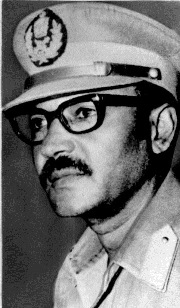Tafari Benti
|
Brigadier General Tafari Benti |
|
|---|---|
| ተፈሪ በንቲ | |
 |
|
|
Chairman of the Derg (de facto Head of State) |
|
|
In office 28 November 1974 – 3 February 1977 |
|
| Monarch | Asfaw Wossen (1974-1975)1 |
| Preceded by | Aman Mikael Andom |
| Succeeded by | Mengistu Haile Mariam |
| Appointed by | Haile Selassie I |
| Personal details | |
| Born | October 1921 Near Addis Ababa, Ethiopian Empire |
| Died |
3 February 1977 (aged 55) Addis Abeba, Derg |
| Military service | |
| Allegiance |
|
| Service/branch | Ethiopian Army |
| Years of service | 1941–1974 |
| Rank | Brigadier General |
| Unit | Second Division Third Division Fourth Divisions |
| 1Crown Prince Asfaw Wossen Tafari had been declared "King-designate" by the Derg but made no move to acknowledge the title, instead recognizing his father, Haile Selassie I, as remaining the de jure Emperor | |
Brigadier General Tafari Benti (Amharic: ተፈሪ በንቲ?; October 1921 – 3 February 1977) was the Head of State of Ethiopia (28 November 1974 – 3 February 1977), and chairman of the Derg, the ruling junta. His official title was Chairman of the Provisional Military Administrative Council.
Tafari Benti was born near Addis Ababa. He joined the Ethiopian army at the age of 20, graduated from the Holetta Military Academy, and served in the Second, Third and Fourth Divisions. In 1967, he served as a military attaché in Washington, D. C., where he and several other Ethiopian colleagues suffered from racial discrimination.
On the evening of 23 November 1974, the charismatic Lt. General Aman Mikael Andom, the president of Ethiopia, and who had been in a struggle for power with the other members of the Derg, was killed in a shootout at his home.Mengistu Haile Mariam served as interim president until the Derg appointed Tafari Benti to the position. He had been serving as brigadier general in the Fourth Division, which was stationed in Asmara, at the time of this appointment.
During his tenure Tafari presented himself as the public face of the ruling junta. According to the Ottaways, while at first he was "a neutral and powerless figure", in the end "he was too colorless, soft-spoken, and undemonstrative to be the figurehead of the revolution." However, according to Rene LaFort's account, Tafari offered some hints that he supported those opposed to Mengistu. One such hint was in July 1975, when in a public speech he made overtures to the civilian left—groups which included the Ethiopian People's Revolutionary Party (EPRP) and MEISON—proposing a united front "of all the forces that rejected the ancient regime, built from the base, that is from the mass organizations born of the great reforms"; LaFort points out that this was "a strategy which Mengistu Haile Mariam and his supporters opposed and would continue to oppose more and more resolutely." He repeated this message in a speech on the first anniversary of the deposition of Emperor Haile Selassie.
...
Wikipedia
